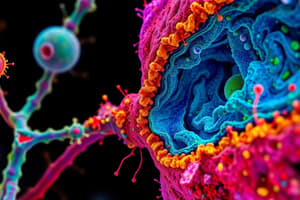Podcast
Questions and Answers
Which property of a microscope is considered more important than magnification?
Which property of a microscope is considered more important than magnification?
- Brightness
- Weight
- Field of view
- Resolving power (correct)
What is the primary function of a fluorescence microscope?
What is the primary function of a fluorescence microscope?
- To increase the brightness of the specimen
- To magnify objects without light
- To observe the absorption and emission of light (correct)
- To provide three-dimensional imaging
Which type of microscope has the highest resolving power?
Which type of microscope has the highest resolving power?
- Fluorescence microscope
- Light microscope
- Phase contrast microscope
- Transmission electron microscope (correct)
What unit of measurement is commonly used in microscopy to express the size of small objects?
What unit of measurement is commonly used in microscopy to express the size of small objects?
Which of the following microscopes employs light interference for observation?
Which of the following microscopes employs light interference for observation?
Which microscope type can visualize surfaces at the atomic level?
Which microscope type can visualize surfaces at the atomic level?
In microscopy, what does the term 'resolution' refer to?
In microscopy, what does the term 'resolution' refer to?
Which type of microscope is most suitable for observing cellular structures?
Which type of microscope is most suitable for observing cellular structures?
What is the primary benefit of using a laser scanning confocal microscope?
What is the primary benefit of using a laser scanning confocal microscope?
Which microscopy technique primarily provides surface imaging rather than internal structure analysis?
Which microscopy technique primarily provides surface imaging rather than internal structure analysis?
Study Notes
Light Waves and Brightness
- In-phase combination of light waves results in an increased amplitude and brightness.
- Out-of-phase light waves partially cancel each other, reducing amplitude and brightness.
Fluorescent Dyes
- Commonly used fluorescent dyes include fluorescein and tetramethylrhodamine.
- Fluorescein emits green light, while tetramethylrhodamine emits red light.
- Example: Mouse cell imaging shows microtubule cytoskeleton (green), nucleus (blue), and actin (red).
Cell Study Methods
- Flow Cytometry: A technique for cell component isolation.
- Centrifugation: Another method for isolating cell components.
Cell Engineering Techniques
- Techniques include cell fusion and various stages like attachment, uncoating, release, transcription, replication, assembly, and translation.
Properties of Cells
- Cells exhibit high complexity and organization, capable of self-regulation and energy utilization.
- Shared structures in all cells: plasma membrane, DNA/RNA, and ribosomes.
- Cells can reproduce and be cultured for extended periods, exemplified by HeLa cells from Henrietta Lacks, cultured since 1951.
Cell Response to Stimuli
- Cells contain surface receptors that detect environmental changes and respond specifically to hormones and growth factors.
Techniques in Cell Biology
- Cytological Study Methods: Includes bright field, fluorescence, laser scanning confocal, phase contrast, transmission electron, scanning electron, scanning tunneling, and atomic force microscopy.
Microscopy
- The most critical aspect of a microscope is its resolving power, which defines the ability to distinguish between closely positioned objects.
- Resolving power for various microscopes varies, affecting the size range of observable objects.
Fluorescence Microscope
- Operates on the principle that specimens absorb light at one wavelength and emit it at a longer wavelength.
- Most fluorescent dyes are designed to emit visible light for imaging purposes.
Studying That Suits You
Use AI to generate personalized quizzes and flashcards to suit your learning preferences.
Related Documents
Description
Test your knowledge on cell biology concepts, focusing on the properties of cells, various light waves, and fluorescent dyes. This quiz also covers methods of cell study and engineering techniques essential for understanding cellular functions.



